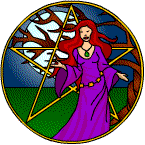Witch Hunts: the dark side of human nature
Created | Updated Oct 10, 2002
Human history is littered with examples of religious persecutions carried out by fundamentalists with an inflated sense of self and self-righteousness, who were intolerant of behaviour that was perceived to threaten the authority of the Church and disturb the status quo. Medieval witch hunts are but one manifestation of this shameful legacy.
Witchcraft and magic in the Middle Ages was condemned as evil and superstitious, with severe laws passed against them, involving the death sentence1. Such practices were considered by the Medieval Church Fathers to be a contemptible relic of paganism.

In 1484 two Dominican Friars, Heinrich Kraemer and Johann Sprenger, induced Pope Innocent VIII to issue a bull authorising the Church to extirpate withcraft in Germany2. Shortly after, they published the Malleus Maleficarum3, a work that became the authoritative encyclopoedia of demonology throughout Christendom4. The book was a synthesis of folk beliefs that had hitherto been manifested in local outbursts of witchfinding5
Amazingly, its authority lasted almost 300 years during the time of the European witch mania6. Lo and behold, out of the demonological bible sprang a systematised theory attributing witches' powers to their special link with Satan, especially their sexual relationship with Old Nick, personified as incubus (if they were women) and as succubus (if they were men)7.
Witches specifically became identified as the earthly representatives of the Prince of Evil8.
Anyhow, the campaign against the devil's earthly representatives was waged long and unrelentingly. The biblical injunction "You should not permit a sorceress to live" was observed repeatedly, even religiously.
Though witch hunts were launched by Roman Catholic evangelists, it was revived and extended by their Protestant counterparts during the Counter-Reformation9.
According to a study of witchcraft in Essex, England following 1560 by ADJ Macfarlane - a modern British historian of witchcraft - the most frequent kind of accusation of witchcraft was the one in which10 someone who had repudiated a neighbour11, usually an old woman seeking a favour12, subsequently attributed some misfortune befalling him to her anger at being refused and thus (logically, of course!) to her witchcraft13.
And now our story swiftly takes us across a vast swathe of water to the land of the free14.
The Pilgrim Fathers15
Sailing in the Mayflower from Plymouth, England, heading for Virginia, N. America, were a group of people in search of greater freedom in which to practice their religious beliefs. Of the 102 members on board, 35 were English Separatists (a radical branch of puritanism), with many Dutch families escaping persecution at home. The settlers finally reached the shores of Cape Cod16 in November 1620. A month later an exploring party arrived in the Plymouth area and shortly after the group established the first colony in New England, Massachusetts. Sadly, half the community died in the first winter, but managed to recover sufficiently to pursue their new life.
We'll skate over the initial hardship and struggle, the many procreations and the occasional barnies with the local indians, and assume these good folk have built their shacks and now settled down to their new life.
We resume the story over two generations later.
The Salem Witch Trials (May - Oct 1692)
The famous or notorious Salem Witch Trials are probably one of the greatest miscarriages of justice ever perpetrated on American soil. For those who need reminding (and for those who have not seen the film), it entails a series of investigations and persecutions that caused 19 convicted "Witches" to be hanged and many other suspects to be imprisoned in the town of Salem in the Massachusetts Bay Colony. Stimulated by voodoo tales told by a West Indian slave, Tituba, a few young girls claimed they were possessed by the devil and subsequently 3 Salem women17, including the said slave girl, were accused of witchcraft18.
Another version of the story is that a previously healthy young girl starts to have convulsions and outbursts of gibberish, baffling the town folk. Others began to manifest the same symptoms until, in two shakes of a witch's broom, there was collective wailing and gnashing of teeth, followed by screams of "foul play" and "the devil's afoot" and "Lock up yer daughters." Anyway, the outcome was very similar.

Tituba and the other accused women were rounded up and taken away to be questioned. Actually they were interrogated ruthlessly, and placed their husbands who were at home patiently waiting for their evening meal under an enormous amount of pressure. After days of confinement, with little food and water, the 3 women began to "crack," incriminating others in false confessions. Well. . .it wasn't long before public hysteria over the threat of witchcraft mounted throughout Massachusetts. Needless to say, the following few days witnessed alot of curtain-twitching, finger-wagging and avoidance behaviour.
Civil magistrates, encouraged by the Clergy19, set up a special court in Salem20 to try those accused of practicing witchcraft - and one Samuel Sewall, one John Hawthorne21, and one William Stoughton were chosen as the court's judges22.
The list of the accused increased and even a Governor's wife was implicated until in total 150 people had been imprisoned and were awaiting trial.
By September, however, the climate of mass hysteria had begun to abate23, and public opinion first stopped, thought about it a bit, and then, on realising what had befallen the community, condemned the trials in the stongest possible terms.
Governer Phips dissolved the special court in October and released the remaining prisoners24. The Massachusetts General Court later annulled the witch trial's convictions and granted indemnities to the families of those who had been executed25
A Synopsis of the witch hunts, persecutions and trials
The famous Salem Witch Trials of 1692 may be regarded as one of the last fitful flares of the witch mania. The indiscriminate accusations that resulted in the execution of innocent people were the result of a general public panic in response to the psychosocial situation, not to the exhortations of clerical bigots.
This fear sprang from a system of beliefs held by most Westerners at the time, and also accounted for the harm done to the 'afflicted' persons.
What I'm saying is that in the final analysis witchcraft worked in Salem because the persons involved believed in it.
The Alternative Synopsis
Before you leave I thought you might like to hear a different synopsis of witch hunting and persecutions, separate from the aforementioned sociological one and more in keeping with a psychoanalytic Freudian interpretation. As you might expect it is based on repressed sexuality in the context of puritanical beliefs26.
Here goes:
Mass hysteria is brought on by repressive religious doctrines which in turn stifle individual sexual expression. This repressed sexuality coupled with intense moral guilt produces a violent psychological backlash which often takes the form of extreme paranoia in which27 innocent victims are imagined to be tormentors. In many cases it is women both old and young that are the innocent victims and the accusers, being largely male, are the real tormentors desperately in need of a good orgasm.
Apart from projective identification and a range of Freudian defence mechanisms, at the end of the day28 it probably boils down to the simple fact that the world shows us the face we show it29.
THE END
